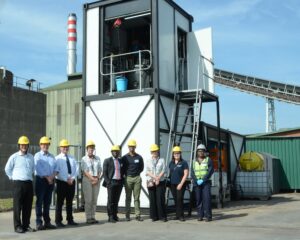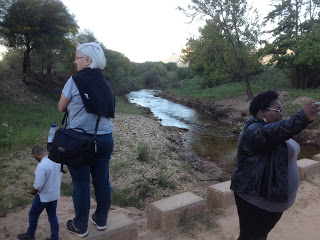
Under most scenarios, water is set to become an increasingly scarce resource in Africa. This is particularly true for southern Africa. The continent loses more water to evaporation than any other continent. Droughts and floods from erratic rainfall patterns, population growth, pollution and urbanisation will all translate to water demand outstripping supply by an estimated 40% by 2030.
Which countries have water in southern Africa?
| Country | Cubic metres per person |
| Angola | 10 510 |
| Botswana | 6 820 |
| Lesotho | 1 680 |
| Malawi | 1 400 |
| Mozambique | 11 320 |
| Namibia | 8 810 |
| South Africa | 1 110 |
| Swaziland | 4 160 |
| Zambia | 9 630 |
| Zimbabwe | 1 550 |
Source: Mike Muller
Some articles:
The 6th of the global goals agreed to by governments in 2015, the Sustainable Development Goals (SDGs), is “Clean water & sanitation” and the 14th is “Life below water”. See www.globalgoals.org.
South Africa is a dry country by world standards. Its climate varies from desert and semi-desert in the west to sub-humid along the eastern coastal area. Its average rainfall of about 450 mm per year is well below the world average of about 860 mm. Evaporation is high, which places extra pressure on this resource.
No truly large perennial river – such as the Congo, Ganges, Mekong, Nile or Rhine which can serve as a reliable source of water – occurs in South Africa . The highly variable rainfall together with the general steep topography and shallow soils, contribute to the flashy character of our rivers. Groundwater is also limited due to the geology of the country, much of which is hard rock with little water bearing capacity. To further aggravate the situation, the spatial distribution of the water resources is highly skewed with 60% of the total annual runoff arising in only 20% of the surface area of the country (eastern parts). The western parts are much more arid than the eastern part of the country.
That South Africans consume more water per capita than the global norm (approximately 237 litres vs 173 litres per day) is hardly encouraging!
Sources: www.sancold.org.za/index.php/about/about-dams/dams-in-south-africa and www.sanews.gov.za/south-africa/spotlight-water.
Find updates on the country’s dams at www.dws.gov.za.
Agriculture is an important sector contributing to the country’s food security, rural welfare and contributing to job creation. Its irrigation component consumes over 60% of the country’s water resources to do this, placing a considerable responsibility on the shoulders of all in the sector. Agriculture faces increased competition for water resources from domestic and industrial users. The following table presents the water resource allocations per water user group:
| Water user/sector | Proportion of allocation |
| Agriculture: irrigation | 60% |
| Agriculture and nature conservation | 2.5% |
| Municipal: urban | 24% |
| Municipal: rural | 3% |
| Industrial | 3% |
| Afforestation | 3% |
| Mining | 2.5% |
| Power generation | 2% |
Source: "The State of SA’s water resources" presentation by Trevor Balzer (Department Water & Sanitation 2014)

| Upstream and downstream: Green Trust/WWF SA media field trip surveying the work done in removing invasive alien plants. . |
In global terms, South Africa is classified as water scarce country. It is the 30th driest country in the world. Possible interventions include:
Source: Dr Willem de Lange, CSIR
Local government is constitutionally mandated to provide basic services including the delivery of water and sanitation services. These municipalities, however, are experiencing systemic issues that negatively affect this delivery.
Municpal consumer debt and poor financial management
While more households have access to piped water than in 2002, there has been a steady decline in the number of households that pay for this piped water. This significantly influences the ability of local government to do its job. In turn, as of 31 December 2022, water boards were owed R16.1 billion due to the non-payment by municipalities’ clients (SA News, 2023).
Poor financial audits against municipalities highlight serious governance and accountability issues in local government. Little meaningful action is taken against officials for non-compliance with supply chain management procedures.
Human resources
Municipalities generally lack the technical knowledge, skill and expertise to perform core operational functions.
Lack of planning
Each municipality is meant to have a water services developmental plan (WSDP) along with its integrated developmental plan (IDP). Mostly, these plans are outdated or not implemented. Maintenance, for example, is in most cases no longer performed as a preventative measure but on a reactive basis.
Infrastructure
As a result of financial and capacity restraints, municipalities are facing a serious backlog in infrastructure maintenance. They lose almost a third of their water supply.
Non-revenue water use accounts to some 37% of water used. This is water lost through faulty infrastructure, commercial losses (billing errors or theft), and unbilled authorised consumption like fire fighting.
Of enormous concern is the proper functioning of wastewater treatment works. Almost half of the country’s 824 wastewater treatment facilities is in a poor or critical condition. This translates into raw sewage flowing into primary water resources like the Vaal River, severly compromising the quality of water.
Source: Michelle Toxopeus, Legal Researcher, Helen Suzman Foundation (adapted)
The country’s rivers tend to be in a weakened condition with only 15% in a good condition (Bega, 2023). The main problems affecting the quality of the country’s river water include faecal pollution, eutrophication (the inflow of nitrates and phosphates), high salinity, high toxicity (from, among other sources, agricultural pesticides) and acid mine drainage. Faecal pollution (which leads to diseases like cholera and typhoid) and pesticides need to be monitored widely, as they pose health risks to human and agricultural activities.
“If there are 100 units of rainwater, only eight units end up in a river. We lose more water to evaporation than what ends up in a river. The era of dam building is over, and the future of water storage lies in managed underground storage aquifers”, Prof Anthony Turton, water resource management specialist.
The South African agricultural sector will have to plan for the uncertainty introduced by climate change, which is already playing havoc with the country’s water security.
Source: Mike Muller
South Africa’s Constitution and the Bill of Rights enshrine the basic human right to have access to sufficient water and a safe and healthy environment.
GOVERNMENT ROLE PLAYERS
Further reference:
| Water resources management, infrastructure planning and development Regulating water services Legislation Budget Entities – Consolidated water boards – Rand Water – Trans-Caledon Tunnel Authority (TCTA) – Umgeni Water – The Water Trading Entity Other Entities – Breede‐Gouritz Catchment Management Agency – Inkomati‐Usuthu Catchment Management Agency – Water Research Commission National Water Policy – National Water Resource Strategy 2 (NWRS2) – Raw Water Pricing Strategy – National Groundwater Strategy – Reuse Strategy – Infrastructure upgrades and bilateral agreements – Rainwater harvesting (RWH) – Desalination Strategy Resources – Dams and water schemes – Groundwater resources – Managing and developing water resources | – Managing water quality and wastewater Strategic Integrated Projects (SIPs) Dam Safety Rehabilitation Programme Water Allocation Reform Programme Women in Water Learning Academy Management of water conservation and demand Enhanced local government support approach Freshwater Programme Monitoring programmes National Chemical Monitoring Programme (NCMP) Integrated Water Quality Management Strategy Managing water resources under a changing climate National Water and Sanitation Master Plan (NW&SMP) National Aquatic Ecosystem Health Monitoring Programme (NAEHMP) National Toxicity Monitoring Programme Education and awareness – Youth development and National Water Week Regional and international cooperation and initiatives Acid Mine Drainage |
Further reference:
Associations, industry bodies and NGOs
Training and research
Companies involved
Visit the websites of the various role players, mentioned earlier on this page.
Refer to the many websites under the “African business environment” and “International business environment” headings.